| The Geographies of
the Black Henna Meme Organism
and
the Epidemic of Para-phenylenediamine Sensitization: A Qualitative
History Catherine Cartwright-Jones PhD Dissertation Geography Department Kent State University 2015 | To ask further questions about henna,
para-phenylenediamine 'black henna' and the epidemic of
para-phenylenediamine sensitization, contact Catherine Cartwright-Jones PhD info@mehandi.com |
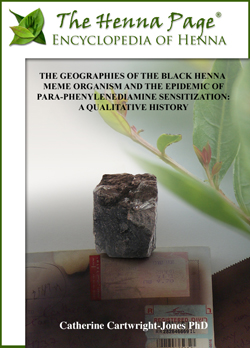 The Geographies of the Black Henna Meme Organism and the Epidemic of Para-phenylenediamine Sensitization: A Qualitative History Click on image to view or download in .pdf format view or download in .doc format Use the above version for research and academic citation: includes complete bibliography and correct pagination. Citation: Cartwright-Jones, C. The Geographies of the Black Henna Meme Organism and the Epidemic of Para-phenylenediamine Sensitization: A Qualitative History. PhD dissertation. 2015. Kent State University, Kent, Ohio. Accession Number: kent1425412566 |
ABSTRACT This qualitative
history investigates the problem of the global epidemic of
para-phenylenediamine
sensitization through the epidemiology of the black henna meme
organism. ‘Black henna’ contains para-phenylenediamine
oxidative
dye, a highly sensitizing chemical which produces delayed
hypersensitivity reactions on the skin. ‘Black henna’ body art evolved
from traditional henna body art when artists began to add
para-phenylenediamine to traditional henna body art because the
chemical dye produced a faster, more efficient, darker stain. This
chemical addition caused blistering, scarring in the area of the
pattern, with a reaction appearing five to twenty days after
application in about 15% to 50% of the subjects.
A maximization test of 10% para-phenylenediamine paste to skin causes sensitization in 100% of subjects in five or fewer applications. All tested 'black henna' pastes have higher concentrations of para-phenylenediamine, from 12% to 80%, and all 'black henna' temporary tattoo applications are larger than a patch test. The connection between the body art and onset of the reaction was not well understood by patrons, and often not seen by the artists. The latent severe chemical sensitivities caused by these applications often remained invisible for years. The ‘black henna’ temporary tattoo became a popular souvenir of exotic destinations and local celebratory cosmetic, as well as a profitable informal economic venture for the artist; the understanding of the risks did not proliferate along with the ‘black henna’ meme. The ‘black henna’ meme replicated from local practice into global cultural geographies through pop culture, tourism, and the Internet. Online and print media commentary about ‘black henna’ began around 1997, at which point the replication and evolution of the black henna meme organism became visible and recoverable, so the epidemiology of the ‘black henna’ meme can be recovered to trace the epidemiology of para-phenylenediamine sensitization. This work analyzes the history, geography and cultural phenomenon of black henna meme organisms in the tourist industry through memetics and discourse analysis of online commentary on ‘black henna’ and the para-phenylenediamine sensitization epidemic produced by ‘black henna’ between 1997 to 2014. This work will also estimate the date of onset and size of the sensitization epidemic, and propose a solution of management through competing meme organisms. |
The Geographies of the Black Henna Meme
Organism and the Epidemic of Para-phenylenediamine Sensitization: A Qualitative History - expanded and illustrated chapters Read the following expanded and illustrated individual chapters for further
detail and discussion.
Click on images below to open in .doc format This is copyrighted material: all rights reserved. If you use this information, please cite source and link back to this page. |
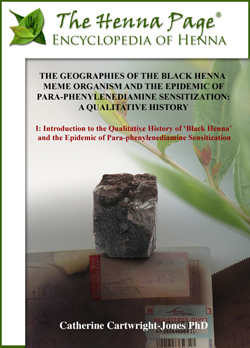 Chapter I: Introduction to the Qualitative History of ‘Black Henna’ and the Epidemic of Para-phenylenediamine Sensitization Chapter I introduces the problems of 'black henna' and the challenges of researching 'black henna.' Read this chapter if you are interested in black henna, the globalization of culture, cultural consumption, or the geograpies of women's economomies, children, informal economies and tourism. Contents: Two Case Studies of ‘Black Henna’ in the Third Space of Tourism: Camilla and Spider Girl Get ‘Black Henna’ in Zanzibar Camilla was in a Third Space Approaching the ‘Black Henna’ PPD Sensitization Epidemic through Cultural Geography Approaching ‘Black Henna’ through Economic Geographies of Women Approaching ‘Black Henna’ Through the Geographies of PPD Approaching ‘Black Henna’ through the Medical Geographies of Delayed Hypersensitivity Reactions in Tourism Approaching ‘Black Henna’ through the Economic Geographies of Tourism Approaching the Geography of ‘Black Henna’ through Cultural Consumption Approaching ‘Black Henna’ through the Geographies of Souvenirs Approaching ‘Black Henna’ through the Geographies of the Informal Economies of Street Vendors Approaching ‘Black Henna’ through Children’s Geographies Positionality | 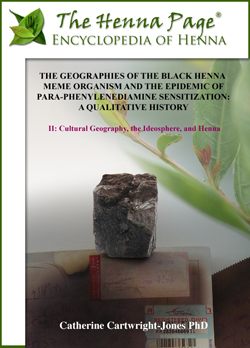 Chapter II: Cultural Geography, the Ideosphere, and Henna Chapter II introduces the study of the body and memetics in cultural geography, and the identification of of 'henna' and 'black henna.' Read this chapter if you are interested cultural geographic methods, the inscribed body in geography, and the memetics of cultural dispersion. Contents: Cultural Geography and the Body Cultural Geography, Memes and the Ideosphere Locating Memes in the Online Ideosphere Locating the ‘Black Henna’ Meme in the Online Ideosphere Cultural Geography, Memeplexes and ‘Black Henna’ The Memes of Body Modification and Globalization in the late Twentieth Century Henna Henna Memes Replicate into the West Henna Memes Online Henna Memes in the Mediasphere The ‘Black Henna’ Meme The ‘Black Henna’ Meme Manifests as Product Black Henna before ‘Black Henna’ Temporary Tattoos |
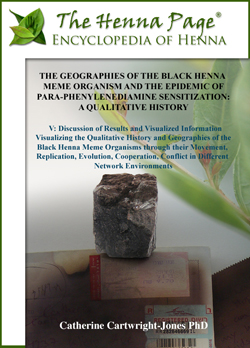 Chapter III. Methodology Chapter III outlines the methods for research on henna, and online research methods for problems in cultural geography through memetics. Read this chapter if you are interested in memetics, and researching cultural dispersion and change online. Contents: Methodology Part 1: ‘Black Henna’ Memes as a Subject for a Qualitative Historical Research Project Web Memetics Memes and Cultural Geography Memes and Henna Globalization of the Henna Memes Approaching the World Wide Web as an Archive The Challenges of Archival Research on the World Wide Web Identifying Returns with Reasonable Certainty Navigating Around FUDD, Trolls, Sockpuppets, and Internet Jackholes Methodology Part 2: Methods of Web Memetics Security and Research Managing Relevant Web Pages by Bookmarking and Tagging Searching the Archive, Constructing the Database Varying the Search Terms Varying the Search Products Quantitative Tags: When, Where, and What Tags for Blended Quantitative and Quantitative Analysis: Who and How, Culture and Place Authority, Authenticity, Formality, Informality, Gender and Age Intention, Pronouncement and Audience Tagging Qualitative Personal Narratives of Events Methodology Part 3: Definitions and Diagrams | 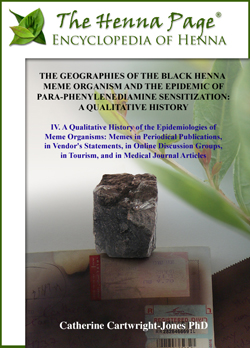 IV. A Qualitative History of the Epidemiologies of Meme Organisms: Chapter IV explains the development of henna and black henna in the English-speaking cultures of the West. Read this chapter if you are interested in the histories of henna and black henna as they emerged into the West between 1970 and 2015. This includes the changing understandings of 'black henna,' the medical studies of 'black henna', 'black henna' vendors, and 'black henna' artists. The 20th Century Understandings of Henna in English Language Publications Contents: Memes as Interactive, Competing, and Evolving Replicators in Network Environments IV. Materials Part 1: Memes in Periodical Publications The Evolution of Black Henna Meme Organisms in the English Language Periodical Publications Indexed by Lexis Nexis prior to the 1990s Henna Meme Organisms in Travel and Local Sections Changes in Traditional ‘Black Henna’ Body Art Techniques with the Availability of PPD 1996: The Rapid Evolution of Henna Meme Organisms Cooperate with Celebrity and Modern Primitive Culture Meme Organisms in the West Henna Meme Organisms Evolve in Mainstream Western Popular Culture and Cooperate with Tattoo Meme Organisms The Black Henna Meme Organism Proliferates and Globalizes in Cooperation with World Beat Pop Music Meme Organisms Reactions to ‘Black Henna’ and the Meme Organism of ‘You Have to be willing to Suffer for Beauty’ Rapid Replication of the Black Henna Meme Organism Cooperating with Celebrity and MTV in 1998 The Meme Organism of Cultural Consumption Competes with the Meme Organisms of Cultural Ownership and Authenticity The Henna Meme Organism Becomes a Signifier in Cooperation with the Trendsetter Meme Organism Marketing ‘Black Henna’ through the Summer of 1998 and Early Warning Memes 2000: The Black Henna Meme Organisms of Injuries and Warnings Emerge in English Language Periodical Media and Compete with the Black Henna Marketing Meme Organisms Henna Meme Organisms Stabilize in Travel, Lifestyle, and Local Sections of English Language Periodical News Publications Late 2000: Henna Meme Organisms Give Rise to New Economic Activities and New Regulations 2001: The Black Henna Warning Meme Organism Evolves Differently in Different Network Environments The Meme Organism of “The West is to Blame” 2002: More Black Henna Injury Meme Organisms from Medical Journal Articles Replicate into the News Media Henna Meme Organisms Cooperating and Conflicting with Memes of Profit, Local Government Regulation, Culture, Warnings, and Free Will 2003: Henna Meme Organism Evolution Slows and Settles into the Networks of Informal Economies, Lifestyles, Multi-Culturalism, and Gains New Territory Legislative and Regulatory Black Henna Meme Organisms Evolve in UK, Canada, and the USA A Seasonal Cycle of Henna Meme Organism Replication Evolves in English Language Periodical Publications The Boundaries of The Black Henna Warning Meme Organism’s Replication in Resort Management and Travel Agencies PPD is awarded the prize of “Allergen of the Year 2007: Black Henna Injury and Warning Meme Organisms Spawn Regulations, Law, Enforcement and Liability 2008: Governments and Physicians Call for Bans Evidence of the Black Henna Meme Organism Replication, Failure to Replicate, and Competition in Commentaries Following Two Articles 2010 – 2013: the Black Henna Meme Organisms in the Network Environments of English Language Periodical News Publications Black Henna Meme Organisms in Local Network Environments in 2009 – 2013 in English Language Periodical News Publications in the USA ‘Black Henna’ Injuries and the Meme Organisms of Cultural Conflict IV. Materials Part 2: Vendors’ Memes The Evolution of Black Henna Meme Organisms in Online Vendor’s Statements Vendors’ Black Henna Merchandising Meme Organisms: Amunez and Tarawa Amunez ‘Black Henna’ and Black Henna Merchandising Meme Organisms Replicate into France through Tarawa, blackhenna.net and blackhenna.com The Black Henna Merchandising Meme Organisms of Amazing Body Art Supply, 1999 – 2001 The Black Henna Merchandising Meme Organism of Blackhennakits.com 2001 – 2013 The Black Henna Merchandising Meme Organisms of ‘Little Miss Henna’ Over-the-Counter Sources of PPD Commonly Used to Make ‘Black Henna’ Temporary Tattoos Production of ‘Black Henna’ in India and Pakistan Marketed in the West IV. Materials Part 3: Online Discussion Memes The Evolution of Black Henna Meme Organisms on hennapage.com and the Henna Page Discussion Forum Black Henna Meme Organism Evolution and Competition in the English Language Henna Page Forum Social Network Environment in 1998 and 1999 Henna Meme Organisms and Black Henna Warning Meme Organisms in the Henna Page Discussion Forum Environment in 2000 IV. Materials Part 4: Memes in Tourism The Qualitative History of Black Henna Meme Organisms in the Network Environments of Travel Forums ‘Black Henna’ Temporary Tattoo Injuries among Bali Tourists: the Evolution of Black Henna Diagnosis, Cause, and Treatment Meme Organisms The Black Henna Libertarian Meme Organism of “It Is My Choice” The ‘Black Henna’ Artists’ Memes Tourists Blogging Transgression and ‘Black Henna’ in Southeast Asia Inversion, Children, and ‘Black Henna’ in the Third Spaces of Tourism Black Henna Meme Organisms in other Travel Advice Forums IV. Materials Part 5: Medical Journal Memes The Evolution of Black Henna Memes Organisms in English Language Medical Journals The Stabilization of Black Henna Injury and Diagnosis Meme Organisms in the Network Environment of English Language Medical Journal Articles Evolutions of the Black Henna Injury and Diagnosis Meme Organisms: Misinformation, Pediatrics, and Sensitizations Cultural Use and the Boundaries of the Black Henna Injury and Diagnosis Meme Organism Replication Black Henna Injury and Diagnosis Meme Organisms Give Rise to Regulation |
 V: Discussion of Results and Visualized Information Chapter V diagrams the memetic evolution of henna and attempts to explain the conflicting understandings of henna and black henna. Read this chapter if you are interested in the the numbers and geographic spread of the para-phenylenediamie sensitization epidemic as caused by 'black henna' in tourism. Visualizing the Qualitative History and Geographies of the Black Henna Meme Organisms through their Movement, Replication, Evolution, Cooperation, Conflict in Different Network Environments Contents: The Archaeology of Knowledge and Memes Global Henna Memetic Replication Memetic Replication in the Third Space of Tourism Global Distribution Pathways of PPD, Warnings, and the Deniability of “Use Only as Directed” The Replication and Evolution of Henna Meme Organisms Evolution of Black Henna Meme Organisms Online through Different Pathways An Idea Ruptures from a Discursive Field and Becomes Knowledge: a Meme Organism Replicates into a Complex Network Environment The Points of Rapid Black Henna Meme Organism Co-evolution in Different Network Environments, and the Different Truths Produced The Emergence of the PPD Identification and Black Henna Warning Meme Organism into Different Network Environments The Seasonal Pulse of the Black Henna Meme Organism PPD Content and Estimates of Sensitization through ‘Black Henna’ Temporary Tattoos Cultural Memes Cooperating and Competing with Black Henna Meme Organisms Beyond the Boundaries of the Online English Language Network Environment | 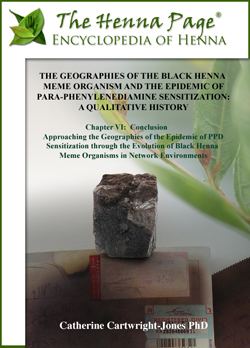 Chapter VI: Conclusion Chapter VI discusses epidemic of para-phenylenediamine sensitization, and possibilities of managing the epidemic through policy and cultural change. Read this chapter if you are interested in problems, policy issues, and potential solutions to the health problems caused by 'black henna.' Approaching the Geographies of the Epidemic of PPD Sensitization through the Evolution of Black Henna Meme Organisms in Network Environments Contents: The Epidemic of PPD Sensitization in Globalizing Culture Approaching Problems in Cultural Geography through Online Memetics The Problems of Globalization, PPD and ‘Black Henna’ Approaching ‘Black Henna’ Through Legal Geographies and the Problems of Creating Policy Approaching the Problem of PPD Sensitization through PPD Warning Meme Organisms in Network Environments |
The Henna Page information is provided free to you by the support of TapDancing Lizard LLC site group and Mehandi.com.